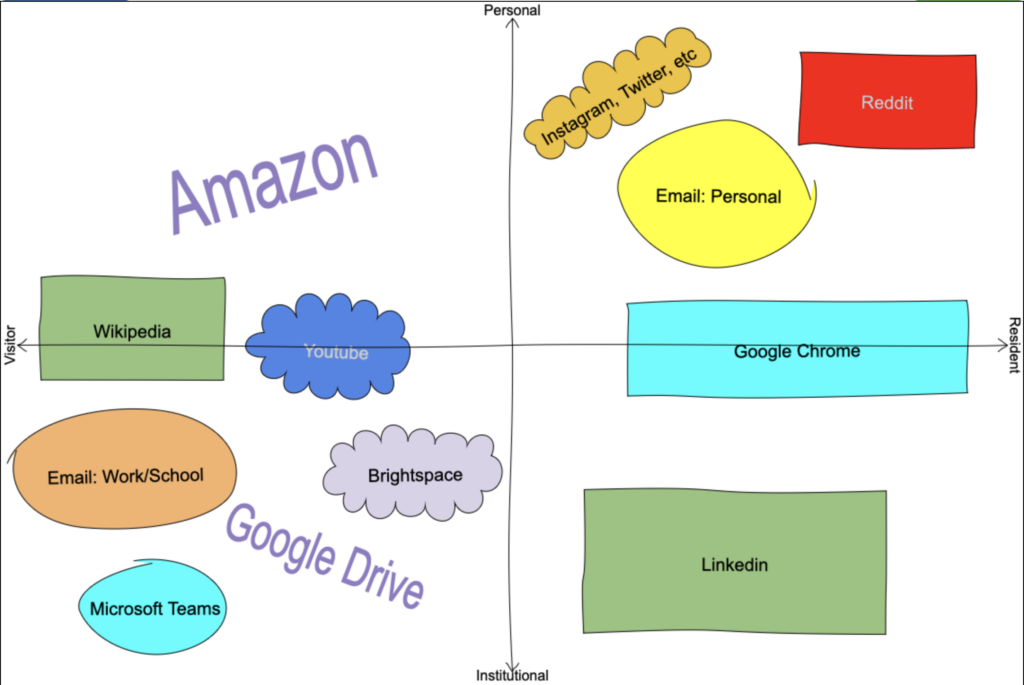
In Week 4, I got the opportunity to create my very own Visitor and Resident Map, which was a fun way to visualize and understand my own engagement with technology and the web. Through this exercise, I was able to reflect on the different types of platforms I use on a daily basis and understand what type of interaction I have with each of them (Visitor/Resident, and/or Personal/Institutional). Evidently, a lot of the platforms I use are heavily institutional, where my role closely ties to a Visitor. For example, BrightSpace, Microsoft Teams, and my Work Email are a couple of the key platforms I use or have used in the past for institutional purposes (School or Past work environments). These are the platforms I usually use on a daily basis to complete a certain task, but would not want to leave any personal traces behind. Others such as LinkedIn, Reddit, or Instagram are platforms that I use for personal as well as professional growth. In these platforms – comparatively – I tend to interact and display more about my personal life. Overall, this exercise was very meaningful and it made me realize more about my digital habits.
When it comes to the digital platforms that students are currently using to developer their professional network, LinkedIn stands the tallest. LinkedIn is the world largest professional networking platform on the internet. The reason why students are preferring LinkedIn compared to others is because of the job opportunities, Alumni connections, and professional development resources. LinkedIn has an abundance to offer for aspiring students who are looking to enter the workforce. By simply having a LinkedIn profile that is well maintained, active, and professional, it will increase the chance of being attracted by potential recruiters. Other than using social media, there are other ways students can try expanding their professional learning network (PLN). The most popular suggestion that many sources recommend is to attend networking events. Majority of the universities offer events where companies around the city, province, or country can come to and communicate with the local students. This is by far the best way to increasing your PLN for better connections, learning opportunities, and growth.
If there is one thing that can limit and/or promote a PLN, it is Data privacy and security. The concern for this results in individuals being more cautious about sharing personal and professional information. Alternatively, the fear of data breaches may discourage them from actively participating and sharing-valuable insights. This can significantly impact community building and networking as these two concepts relies on the exchange of information. Ultimately, this causes individuals to lack a digital identity, which is important in today’s interconnected/ digitalized world. On the flip side, Data privacy and security can also promote PLN. By having a secure platform where people can safely communicate can result in innovation and collaboration. If individuals find the platform safe, they feel comfortable sharing ideas which promotes active participating and knowledge exchange within the community.
Creating a reputable digital identity is crucial for creating a good PLN. As a user in a digital network, having strategic as well as having mindful actions will ensure that I will have a positive identity or reputation. Being consistent through each of the platform I use is the most important factor of gaining a reputation. By simply have an account in each platform that has a professional picture, username and bio, will ensure that I have a recognizable and cohesive identity. This makes it easier for others to identify and connect with me across various online networks. Moreover, a simple action to ensure you have good reputation/identity is by simply Googling yourself. Regularly checking your name on the internet and addressing any potential negative content is advisable to prevent future impacts on your reputation.
When applying for jobs, employers commonly assess your online presence through your digital identity. When it comes to my online presence, I would say my digital identity is quite controlled. After searching my name on any search engine, the online platform that comes is LinkedIn. Although my LinkedIn is up-to-date, it still showcases some of my experiences and education – potentially being interesting to an employer. Other than LinkedIn, my other social media platforms can be found by searching for my name; however, all of them are private, so future employers have no access to them.